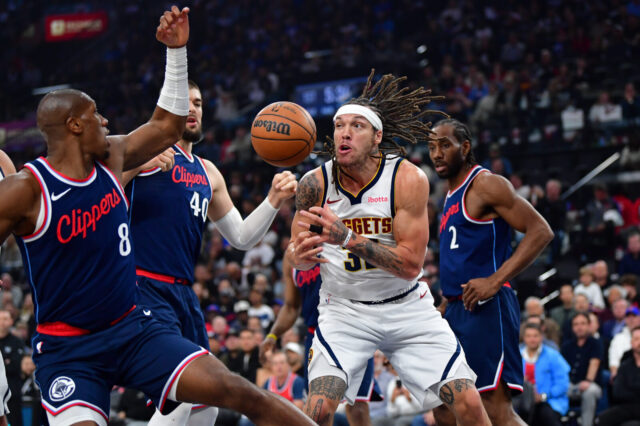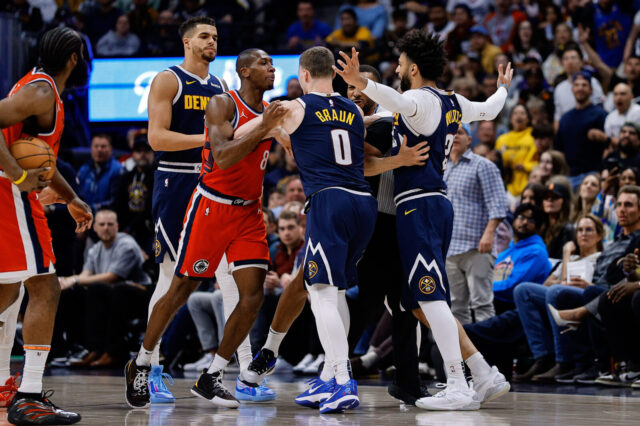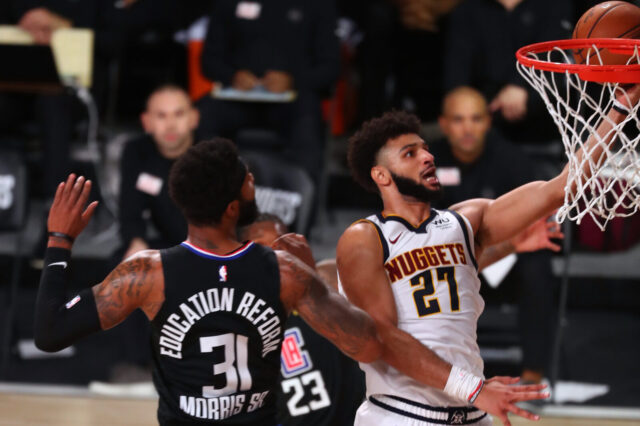It was by far the most impressive shot of the evening for either side.
Nikola Jokić received the ball at the top of the circle 18 feet away from the basket in the closing seconds of the fourth quarter. He had a mismatch against Amir Coffey that he would normally try to back down toward the basket, but there was no time left to make a significant move. So, Jokić broke out Ol’ Faithful, hitting a Sombor Shuffle falling away from the basket and draining a clutch shot that bailed out yet another awful Denver Nuggets possession.
First of all, look at the above shot. That’s incredible. Sometimes, it’s easy to forget that Jokić still has that shot in his bag. He hasn’t made a ton of Sombor Shuffles this season, and this one had a high degree of the difficulty dribbling directly away from the basket.
Second of all, look at the rest of the floor. It’s a complete mess. Three Los Angeles Clippers defenders have a foot in the paint, and a fourth, Eric Bledsoe, doesn’t care at all if Facu Campazzo catches a pass for an open three with the way Bledsoe is positioned. What Jokić has been facing lately defensively is some of the most difficult spacing of his entire career. Denver’s shooters are only theoretical, especially in the Clippers game where Denver shot 4-of-33 from three-point range. Take away Jokić’s attempts and Denver shot 10% from three on the evening.
The Nuggets have dropped to a 108.3 Offensive Rating during the 2021-22 season, which ranks 24th in the NBA. They’re officially reaching pitiful levels on the glamorous end of the floor, despite featuring Nikola Jokić for roughly 33 minutes every single game.
The Nuggets have been facing tougher and tougher defensive coverages against Jokić that are predicated on making his life as difficult as possible. As a result, the Nuggets are facing a shot clock problem offensively.
This content is no longer available.
The above table is extremely colorful and filled with information, so let’s break it down section by section.
Early Shot Clock
Generally, the best time to score a basket is before the opposing defense is set. Defenders are human, and during a game, there are plenty of times where they forget their assignment in the first five seconds, or a team is cross-matched from the previous possession and struggles to recover in time. Sometimes, defenders can be lazy and don’t get back into defensive position anyway, which means there are occasionally opportunities to find an easy shot early in the shot clock if the offense dedicates itself to hustling the ball up the court.
The problem for Denver: they play at the 25th fastest pace in the NBA. They don’t score the ball early, and they certainly don’t do it often. The Nuggets are methodical. If they don’t have a fast break opportunity in the first few seconds of the shot clock, they often reset the possession, get the ball to Nikola Jokić, and let him make something happen. From 18 to 15 seconds on the clock, the Nuggets have the lowest frequency of shot attempts in the entire NBA at 13.5% of their total field goal attempts.
To be clear, that isn’t necessarily a good or bad thing by itself. Plenty of elite offenses play at a methodical pace. As can be seen during the 2020-21 season, the Nuggets offense was awesome and ranked 29th in 18 to 15 second shot clock frequency. In 2021-22, they still rank 10th in the NBA, so while it’s taken a dip, they’re still doing okay when they search for an early shot.
Average Shot Clock
The vast majority of shooting possessions happen during the window of 15 to 7 seconds left on the shot clock. Around the NBA, about 48% of all field goal attempts occur during that timeframe, which is right in line with where the Nuggets are.
For three consecutive years, the Nuggets have shot the ball with elite efficiency during an average shot clock possession. Often, Jokić will operate the pick and roll, dribble handoff, and cutting/duck-in system that the Nuggets employ. Through high level decision making, the ball almost always finds an open target when Denver can get off a shot during the 15 to 7 second window. This season, the Nuggets rank third in eFG% at 55.7%
Still, it’s pretty clear that the Nuggets are trending in the wrong direction with how many of their shots occur during this window. Going from seventh in shooting frequency in 2019-20 to 11th in 2020-21 to 15th this season is a pretty straight line. It’s not a stark change, but the margins matter for a team as injured as the Nuggets are this season. The difference between Denver’s eFG% in the “average shot clock” window versus the “late shot clock window” is tangible.
Late Shot Clock
For the purpose of this discussion, let’s fold in both 7 to 4 seconds and 4 to 0 seconds into this section. Once the Nuggets reach the seven-second mark, panic often seems to ensue. Generally, the Nuggets are hoping to get Jokić the ball in these situations, but that has been a difficult prospect with the Nuggets as injured as they are.
Lately, it’s been getting ugly.
The above and below clips have truly driven home Denver’s issues with shot clock execution late in games. When things slow down and teams load up on Jokić, the Nuggets have needed somebody to step up and serve as a release valve for tough possessions. For many years, it was Jamal Murray, and it might still be when he returns. Right now, Will Barton and Monte Morris are basically splitting ball handling duties late in games. When those two don’t have the ball, the execution has pulled the bottom out from under Denver’s offense.
Notice Jokić isn’t anywhere near the top of the key to receive the ball? He gave up a fool’s errand of Denver’s other ball handlers trying to pass him the ball and instead went to the paint to try and rebounding an impending shot that was more certain to miss than a broken clock being right twice a day.
On the season, the Nuggets rank top five in both shot frequency from 7 to 4 seconds and shot frequency from 4 to 0 seconds. When combining the two, only the Cleveland Cavaliers and Dallas Mavericks utilize a higher percentage of their shots late in the shot clock. Neither of those teams are “good” offenses, ranking 14th and 17th respectively.
The frequency is by far the biggest issue here. The Nuggets settle for bad shots when they get pushed late into the shot clock. They have one of the lowest three-point percentages in the NBA after the shot clock hits 7. The layups around the rim are often closer to prayers than actual shots the Nuggets are hoping for, and they average a high number of deep threes late in the clock, generally heavily contested.
When the process breaks down, the Nuggets don’t have a counter. They don’t have a player to consistently throw the ball to outside of Jokić, and when the Nuggets can’t get him the ball, they get up a garbage attempt instead.
It’s easy to say “just shoot faster” or “run harder” when trying to identify solutions, but the problems run deeper than a simple mentality change. With Jokić carrying so much offensive responsibility while also contesting many shots defensively and rebounding at the center position, there’s only so hard the Nuggets can push him until he breaks. Denver’s slower pace has generally been to accommodate both Jokić’s play style and workload, but even when he’s off the court, the Nuggets don’t exactly turn on the afterburners. With Jokić OFF the court, the Nuggets average just under half a possession more per 100 possessions, which means they’ve turned up the pace just a minimal amount.
The Nuggets have simply been inept offensively when Jokić sits. They struggle to get into the teeth of the defense with their guards, which should be the identity of a group utilizing Jeff Green, JaMychal Green, and Zeke Nnaji as big man floor spacing options. Find a guard that collapses the defense, rotate to an open shooter, and live with the results. Denver hasn’t been able to complete the first step of that “plan,” which is an indictment of Facu Campazzo as the primary backup point guard and Bones Hyland as the player Denver hoped would be able to offer that exact skill set.
The hope is for Jamal Murray to solve a lot of these problems when he returns. Part of that hope stems from him being the best on the team as a late clock dribbling option for a number of years, but also because Denver should be able to stagger Monte Morris and Will Barton to alleviate some of the second unit’s burden.
Until then though, expect plenty of late shot clock possessions where the Nuggets struggle to find their ideal shot, leaving the offense to devolve into something unbecoming of Jokić-ball at its core.


